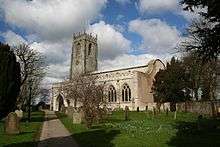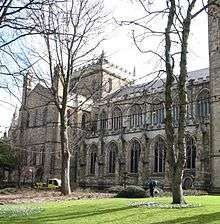Sydney Robert Elliston
Canon Sydney Robert Elliston MA (1870 – 23 October 1943) was a journalist, vicar, and canon of Ripon Cathedral. Two of his brothers were William Rowley Elliston and George Elliston MP. He was involved with the formation of the Ripon Diocesan Board of Finance in 1913, and was its secretary from 1914 to 1935. At his funeral it was said of him that, "The diocese of Ripon owed a great debt to the work of Canon Elliston in laying down sound principles of Church finance."[1][2] While looking after the finances of Ripon diocese, he was at the same time vicar of one of north-east England's Barber churches: the Church of St Thomas the Apostle, Killinghall (1880), designed by William Swinden Barber.[3][4]
Sydney Robert Elliston | |
|---|---|
| Canon | |
Canon Elliston | |
| Church | 1894 St Mary & Martin, Blyth 1898 St Michael, Retford 1901 St Mark, New Lakenham 1904 St Thomas, Killinghall |
| Orders | |
| Ordination | 1895 (priest) by Suffragan Bishop of Southwark |
| Personal details | |
| Born | 1870 Ipswich, England |
| Died | 23 October 1943 (aged 72–73) Killinghall, England |
| Nationality | British |
| Spouse | Amelia Tanner Causton |
| Alma mater | Pembroke College, Oxford |
| Signature | |
Life
His grandfather William Elliston, and his uncle, George Elliston, were medical practitioners.[2] His father William Alfred Elliston MD (1840–1908) was a physician and surgeon of Stoke Hall, Ipswich.[1][5][6][7] His mother was Janet Potter (1846–1891).[8][9]
He was born at Ipswich in 1870, one of nine siblings.[10] His older brother was Major William Rowley Elliston OBE (1869–1954), who was a barrister, Recorder for Great Yarmouth and Mayor of Ipswich. A younger brother was Guy Elliston (1872–1918) who was financial secretary of the BMA and died of pneumonia.[2][11][12] Another younger brother, George Elliston KGStJ MC MA (1875–1954), was a publisher and barrister, and Conservative Member of parliament for Blackburn 1931–1946.[1] His youngest brother Chatterton Eric Elliston (1882–1960) trained as a surgeon but practised as a GP at Porthleven, Cornwall.[2][13]
Sydney Robert was educated at Ipswich School and was a scholar of Pembroke College, Oxford,[1] gaining a 2nd class mathematics Honour Moderations in 1890, a 3rd class BA in mathematics in 1892, and his MA in 1895.[3][14]
He married Amelia Tanner Causton (1870–1925) of Bickley, south-east London, in Paddington in 1904; she was a niece of Lord Southwark.[1][15][16][17] They had three children, all born at Killinghall: Stephanie Josetta (b.1906), Doreen Violet Mary (b.1908) and Sydney Amyot (b.1909).[18]
In 1935 he resigned from his post as vicar of Killinghall due to ill health.[19][20][21][22] He suffered a stroke and later moved to a nursing home.[23] He died on 23 October 1943 at Moor Close in Killinghall, aged 73 years.[24][5][6] His funeral took place on 26 October 1943, conducted at Killinghall by the Bishop of Knaresborough, the Archdeacon of Leeds, and Canons R. Pulleine and H.J. Peck of Ripon Cathedral. Present in their vestments were Rev. H.R. Stott of Beckwithshaw, Rev. H.D. Pearson of Bilton, Rev. F. Tite of Harrogate, Rev. H. Griffiths Vicar of Harewood and Rev. L. Shorland-Ball, vicar of Killinghall. The funeral was attended by a large number of officers of the financial departments of Ripon Cathedral, local clergy, and others who had travelled some distance when private travel was difficult during World War II.[25]
Work
He was on the staff of the Morning Leader 1892–1894.[3][14] He was ordained deacon in 1894, and priest in 1895 by the Suffragan Bishop of Southwark.
St Mary and St Martin's Church, Blyth

He was curate of St Mary and St Martin's Church, Blyth, 1894–1898.[3][14][26] On 10 June 1896 he was best man at the wedding of Reverend F.W. Keene, vicar of St John the Baptist church, Misson, Nottinghamshire, where the bridal party wore satin, silk and velvet and carried gifts of gold, refreshments were provided by Buzzard of Oxford Street, and the married couple were to honeymoon on the Continent.[27] When he left Blyth Church, he was presented on Monday 25 June 1898 by 200 people from the parishes of Blyth, Ranskill and Barnby Moor with an illustrated address and a gift of "solid silver communion plate and candlestick enclosed in a handsome leather bag, suitably inscribed, together with a purse containing thirty sovereigns." Around the same time, the Ranskill Ambulance Association presented him with a brass inkstand and letter holder.[28]
St Michael the Archangel's Church, Retford

He was vicar of St Michael the Archangel's Church, Retford 1898–1901.[3][14]
St Thomas the Apostle, Killinghall
As Vicar at St Thomas from 1904 to 1935, he covered the hard years of the Great War and the Great Depression. He was installed as vicar of Killinghall in 1904. His patron was Sir Henry Day Ingilby. His gross income was £325 per annum, net £300 plus vicarage. The parish population was 809 by 1904.[3][14]
From 1905 to 1908 Elliston undertook a major re-ordering of the chancel. Using the designs of C. Hodgson Fowler, he raised the floor, replaced the chancel steps, and extended the choir stalls. Using oak and the same architect, he added a chancel screen, panelling, a retable and a new altar.[29]
Elliston "was involved in many aspects of village life [and] was responsible for plans to improve and alter the chancel of the church in 1905." His churchwardens were John Hirst and George Lewis. He established the Killinghall parish magazine which ran for many years from 1904.[23] In 1922 the West Riding Education Authority suggested that the village church school and board school should be amalgamated to save £300 per year, but Canon Elliston's objections on the grounds of religion's precedence over economy were respected. By 1937 the issue had been raised again, and the board school became the village hall. However the school continued to require space in the village hall for many years, showing Canon Elliston's objection to be valid for other reasons.[30] In 1915, he was involved in the setting up of a Church Tent for assistance in the nearby encampment of 5,000 soldiers at Penny Pot. In 1916 as a trustee of the Parish Room he was involved in its temporary conversion into a Soldiers' Club for the same men.[31] On Fridays in the 1920s, the village school children were marched into the church for a service, and since headgear was mandatory in church, the girls had to wear knotted handkerchiefs on their heads. Sometimes Elliston would visit the school to teach the catechism.[32]
It was Elliston who proposed in 1919 that a village war memorial of stone should be erected, and this was designed by architect W.H. Wood,[33] and unveiled in 1921. He also proposed an inscribed brass war memorial tablet within the church, and this was also designed by Wood and unveiled on the same day.[34]
In June 1927, Elliston had a spat in The Yorkshire Post with D'Arcy S. Rudd, vicar of St John's church, Leeds, about attendance rates at Sunday schools. Elliston disputed Rudd's figures, and Rudd accused Elliston of complacency.[35]
Ripon Cathedral

He sat on the 1912 Commission which considered the reorganisation of church finance as recommended by the archbishops. This led to the formation of the Ripon Diocesan Board of Finance in which he was closely involved from 1913. He was its clerical secretary 1914–1918, and from 1928 to 1935. He was general secretary 1918–1928. He was associated with the Ripon Diocesan Queen Victoria Clergy Fund, and was official secretary of Ripon diocese Church Building Society from 1914.[1] In his obituary, the Yorkshire Post and Leeds Intelligencer reported that Mr A.B. Leigh, secretary of the Ripon Diocesan Board of Finance, said that, "The diocese of Ripon owed a great debt to the work of Canon Elliston in laying down sound principles of Church finance, and the clergy of the diocese were indebted to him for his interest in the improvement in their incomes."[1] He was honorary canon of Ripon Cathedral and proctor convocation of Ripon from 1921,[1] and canon in 1928. He was clerk to the Darnborough fund 1921–1939.[1] At his retirement from Killinghall he was made canon emeritus.[1] By 1935 his benefice had been increased by 1.25 acres of glebe land to the value of £4. His ecclesiastical commission was £400, and fees £4, so his net income was £408 plus the vicarage. One reason for this was that he had extra responsibilities and the parish population had risen to 1098.[14]
References
- Yorkshire Post and Leeds Intelligencer West Yorkshire, England 25 October 1943, back page: Death of Canon S.R. Elliston, good work for church finance
- Brindale: Pentre House
- Crockfords Clerical Directory (1907) part I. Oxford
- Pateley Bridge and Nidderdale Herald, 31 July 1880: "Killinghall: consecration of a new church at Killinghall". On microfilm at Victoria Library, Harrogate, North Yorkshire, England
- Manchester Evening News Greater Manchester, England 25 October 1943 p4: "Canon's death at Harrogate"
- "Index entry". FreeBMD. ONS. Retrieved 6 September 2016. Deaths Dec 1943 Elliston Sydney R 73 Knaresboro Vol9a p125
- National Portrait Gallery, Collections: William Alfred Elliston
- Gravestone photographic resource: Janet Elliston
- "Index entry". FreeBMD. ONS. Retrieved 20 September 2016. Marriages Jun 1865 Potter Janet Dartford 2a 442
- "Index entry". FreeBMD. ONS. Retrieved 6 September 2016. Births Dec 1870 Elliston Sydney Robert Ipswich Vol4a p566
- "GUY ELLISTON". Br Med J. 1 (2990): 468–469. 1918. doi:10.1136/bmj.1.2990.468-a. PMC 2340232.
- "Index entry". FreeBMD. ONS. Retrieved 20 September 2016. Births Mar 1872 Elliston Guy Ipswich Vol4a p650
- Helston history: Dr Elliston MD
- Crockfords Clerical Directory (1935). Oxford
- "Index entry". FreeBMD. ONS. Retrieved 6 September 2016. Marriages Dec 1904 Elliston Sydney Robert Padington Vol1a p65
- "Index entry". FreeBMD. ONS. Retrieved 26 September 2016. Births Jun 1870 Causton Amelia Tanner Greenwich 1d 805
- "Index entry". FreeBMD. ONS. Retrieved 26 September 2016. Deaths Mar 1925 Elliston Amelia T 54 Knaresborough 9a 164
- United Kingdom Census 1911
- Register of Baptisms for St Thomas the Apostle, Killinghall. On microfilm at North Yorkshire County Record Office, Northallerton.
- Pateley Bridge and Nidderdale Herald, Friday 15 August 1980: "Notes from Nidderdale" by Chad. On microfilm at North Yorkshire County Record Office, Northallerton, microfilm 3253, frame no.02296.
- Killinghall parish records 0240 PR/KLG 2–12. On microfilm at North Yorkshire County Record Office, Northallerton. Microfilm 3253.
- Genes ReunitedYorkshire Post and Leeds Intelligencer West Yorkshire, England 30 September 1935
- Waite 2000, p. 77.
- Yorkshire Post and Leeds Intelligencer West Yorkshire, England 25 October 1943 p1: Death of Canon S.R. Elliston, good work for church finance
- Yorkshire Post and Leeds Intelligencer West Yorkshire, England 27 October 1943 p3: Canon S.R. Elliston. On Genes Reunited.
- Derby Mercury Derbyshire, England 23 May 1894: "Ordination service at Long Eaton: deacons"
- Derbyshire Times and Chesterfield Herald Derbyshire, England 20 Jun 1896: "Marriage of the Rev. F.W. Keene of Bawtry"
- Nottinghamshire Guardian Nottinghamshire, England 25 Jun 1898: "Local and District News, presentation at Blyth"
- West Yorkshire Archive service, Morley: Document RD/AF2/19/26 (1905) Killinghall faculty
- Waite 2000, pp. 83–84.
- Waite 2000, p. 109.
- Waite 2000, p. 225.
- William H. Wood (fl.1889–1939) architect of Newcastle on Tyne Archived 3 October 2016 at the Wayback Machine
- Waite 2000, pp. 145–146.
- Yorkshire Post and Leeds Intelligencer West Yorkshire, England 10 Jun 1927: "Sunday schools"
Bibliography
- Waite, Colin (2000). Reflections of Killinghall: its past and its people. Killinghall, North Yorkshire: Killinghall Parish Council. p. 266. GBA107858.CS1 maint: ref=harv (link)